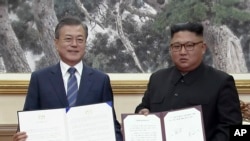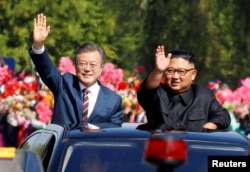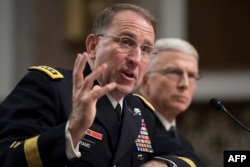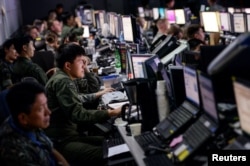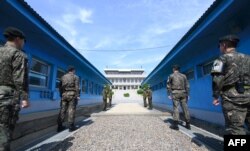U.S. President Donald Trump announced this week he would have a second summit with North Korean leader Kim Jong Un “in the not-too-distant future.” Progress on denuclearizing the peninsula and restarting talks between Kim and Trump garnered much of the attention following the third inter-Korean summit last week.
But a comprehensive military agreement signed the same day by Kim and South Korean President Moon Jae-in, hasn’t received as much attention. If implemented, it stands to formulate how future military interactions are to take place between both Koreas.
“Security confidence-building measures to reduce the potential for miscalculation and escalation of military hostilities is welcome,” wrote Bruce Klinger, Senior Research Fellow for Northeast Asia at the Heritage Foundation, in an email to VOA.
“But Moon risks going too far by lowering allied defenses before North Korea's conventional threat to South Korea, and U.S. troops stationed [in South Korea], is reduced,” he said.
The readiness of U.S. troops on the peninsula was brought up Tuesday in Washington, where Army General Robert Abrams has been nominated to be the next commander of American forces in South Korea.
He testified before the Senate that suspending the Ulchi-Freedom Guardian joint military exercise has had an effect.
"I think there was certainly degradation to the readiness of the force," Abrams said.
However, Abrams said he was confident the current U.S. Forces Korea commander's mitigation plan would sustain readiness.
Establishing peace through non-confrontation
North and South Korea vowed to “completely cease all hostile acts against each other in every domain” as part of their comprehensive agreement signed last week in Pyongyang.
To achieve this, both sides promised to resolve any differences peacefully and have “consultations on matters including large-scale military exercises and military buildup aimed at each other.”
Seoul and Pyongyang plan to employ direct lines of communication, the operation of an Inter-Korean Joint Military Committee, and the adoption of a five-step process to prevent accidental clashes.
Both sides also agreed to cease military exercises inside the demilitarized zone (DMZ) from November on and established a series of no-fly zones and a maritime peace zone in the waters off the peninsula’s western coast.
Furthermore, the agreement has the goal of transforming the DMZ into a peace zone by completely removing all guard posts that are within one kilometer of one another as a preliminary step, that ultimately would lead to their complete removal and eventual demilitarization of the Joint Security Area.
Security implications
The agreement reflects “a logic of reciprocal restraint,” wrote Victoria University of Wellington Senior Lecturer Van Jackson to VOA, who outlined two goals for the security realm: building confidence and managing risks.
“If implemented as stated, I think this agreement will go a long way toward managing risk and inadvertent conflict,” said Jackson, although he doubts the changes will do little to sway perceptions about each side's intentions.
While fighting on the Korean Peninsula ended in 1953 and in the absence of imminent war, Jackson said removing the guard posts poses little risk other than delaying response time should North Korea move across or attempt to re-occupy it.
Jaeho Hwang, the Director of the Global Security Cooperation Center at Hankuk University of Foreign Studies, said the compromises in the agreements made by Seoul and Pyongyang were done to facilitate arms control and de-escalate hostilities.
Hwang said upholding the agreement is also in Kim Jong Un’s best interest. He said if Kim were to break the agreement, that could reverse current progress toward eliminating potential conflict.
If a perceived military threat from North Korea would re-emerge, according to Hwang, it could possibly cause Moon’s popularity to drop and potentially result in a future conservative government that takes a harder line against Pyongyang.
The safe zones outlined in the joint agreement may also reduce uncertainties in the region, even though many of its flash-points are located off the peninsula.
Jackson said that it’s “important not to overstate” the positive aspects of the agreement, because it doesn’t address all concerns. "Even if it is implemented,” said Jackson. He added that everything in it is “easily reversible.”




